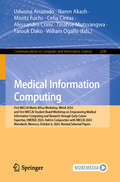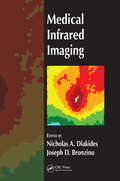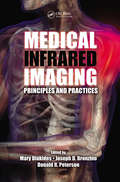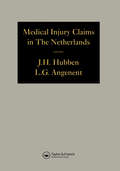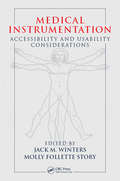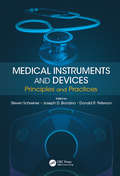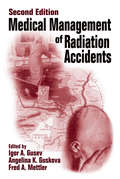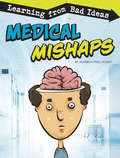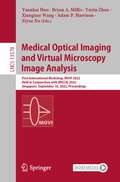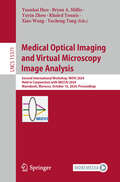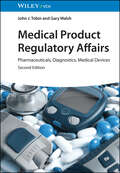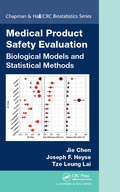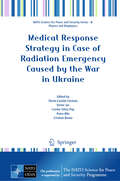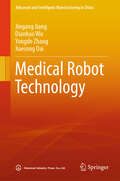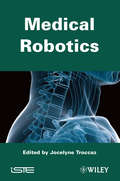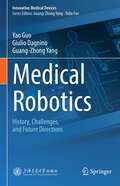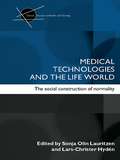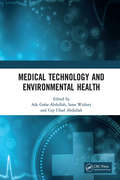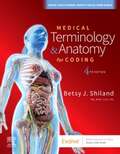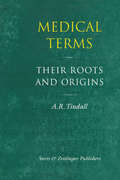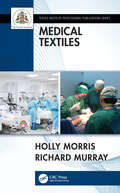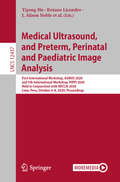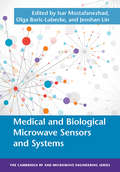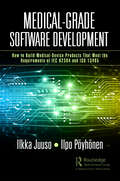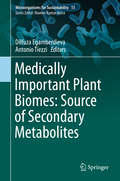- Table View
- List View
Medical Information Computing: First MICCAI Meets Africa Workshop, MImA 2024, and First MICCAI Student Board Workshop on Empowering Medical Information Computing and Research through Early-Career Expertise, EMERGE 2024, Held in Conjunction with MICCAI 2024, Marrakesh, Morocco, October 6, 2024, Revised Selected Papers (Communications in Computer and Information Science #2240)
by Alessandro Crimi Celia Cintas Udunna Anazodo Naren Akash Moritz Fuchs Tinahse Mutsvangwa Farouk Dako Willam OgalloThis book presents a series of revised papers selected from the First MICCAI Meets Africa Workshop, MImA 2024, and First MICCAI Workshop on Empowering Medical Information Computing and Research through Early-Career Expertise, EMERGE 2024, which was held in Marrakesh, Morocco, during October 6, 2024. MImA 2024 accepted 21 full papers from 45 submissions; for EMERGE 8 papers are included from 9 submissions. They describe cutting-edge research from computational scientists and clinical researchers working on a variety of medical image computing challenges relevant to the African and broader global contexts, as well as emerging techniques for image computing methods tailored to low-resource settings.
Medical Infrared Imaging
by Joseph D. Bronzino Nicholas A. DiakidesRapid evolution of technical advances in infrared sensor technology, image processing, ‘smart algorithms, databases, and system integration paves the way for new methods of research and use in medical infrared imaging. These breakthroughs permit easy-to-use, high-sensitivity imaging that can address key issues of diagnostic specificity and engende
Medical Infrared Imaging: Principles and Practices
by Joseph D. Bronzino Donald R. Peterson Mary DiakidesThe evolution of technological advances in infrared sensor technology, image processing, "smart" algorithms, knowledge-based databases, and their overall system integration has resulted in new methods of research and use in medical infrared imaging. The development of infrared cameras with focal plane arrays no longer requiring cooling, added a new
Medical Injury Claims in the Netherlands 1980-1990
by Joseph H. HubbenThis text offers a comprehensive insight into the management of, and the legal, medical and financial aspects of, medical insurance claims. The co-operation of a number of major insurance companies enabled one third of all medical claims in a ten-year period to be studied.
Medical Instrumentation: Accessibility and Usability Considerations
by Jack M. Winters Molly Follette StoryTwo of the most important yet often overlooked aspects of a medical device are its usability and accessibility. This is important not only for health care providers, but also for older patients and users with disabilities or activity limitations. Medical Instrumentation: Accessibility and Usability Considerations focuses on how lack of usabi
Medical Instruments and Devices: Principles and Practices
by Joseph D. Bronzino Donald R. Peterson Steven SchreinerMedical Instruments and Devices: Principles and Practices originates from the medical instruments and devices section of The Biomedical Engineering Handbook, Fourth Edition. Top experts in the field provide material that spans this wide field. The text examines how biopotential amplifiers help regulate the quality and content of measured signals. I
Medical Management of Radiation Accidents
by Kenneth S. CohenAlthough radiation accidents are rare and often complex in nature, they are of great concern not only to the patient and involved medical staff, but to the media and public as well. Yet there are few if any comprehensive publications on the medical management of radiation accidents. Medical Management of Radiation Accidents provides a complete refe
Medical Mishaps: Learning from Bad Ideas (Fantastic Fails)
by Elizabeth Pagel-HoganSee some of the world's most messed-up medical mishaps at a microscopic level. Find out how each procedure, tool, or surgery failed, the basic science that was missed, and what doctors learned from their mistakes.
Medical Optical Imaging and Virtual Microscopy Image Analysis: First International Workshop, MOVI 2022, Held in Conjunction with MICCAI 2022, Singapore, September 18, 2022, Proceedings (Lecture Notes in Computer Science #13578)
by Ziyue Xu Yuankai Huo Bryan A. Millis Yuyin Zhou Xiangxue Wang Adam P. HarrisonThis book constitutes the refereed proceedings of the 1st International Workshop on Medical Optical Imaging and Virtual Microscopy Image Analysis, MOVI 2022, held in conjunction with the 25th International Conference on Medical Imaging and Computer-Assisted Intervention, MICCAI 2022, in Singapore, Singapore, in September 2022. The 18 papers presented at MOVI 2022 were carefully reviewed and selected from 25 submissions. The objective of the MOVI workshop is to promote novel scalable and resource-efficient medical image analysis algorithms for high-dimensional image data analy-sis, from optical imaging to virtual microscopy.
Medical Optical Imaging and Virtual Microscopy Image Analysis: Second International Workshop, MOVI 2024, Held in Conjunction with MICCAI 2024, Marrakesh, Morocco, October 10, 2024, Proceedings (Lecture Notes in Computer Science #15371)
by Xiao Wang Yuankai Huo Bryan A. Millis Yuyin Zhou Khaled Younis Yucheng TangThis book constitutes the refereed proceedings of the Second International Workshop on Medical Optical Imaging and Virtual Microscopy Image Analysis, MOVI 2024, held in conjunction with the 26th International Conference on Medical Imaging and Computer-Assisted Intervention, MICCAI 2024, in Marrakesh, Morocco, in October 2024. The 21 regular papers presented at MOVI 2024 were carefully reviewed and selected from 29 submissions. They are grouped into these two topical sections: Medical Optical Imaging and Virtual Microscopy Image Analysis and Kidney Pathology Image segmentation (KPIs) Challenge.
Medical Product Regulatory Affairs: Pharmaceuticals, Diagnostics, Medical Devices
by Gary Walsh John J. TobinMedical Product Regulatory Affairs Hands-on guide through the jungle of medical regulatory affairs for every professional involved in bringing new products to market Based on a module prepared by the authors for an MSc course offered by the University of Limerick, Ireland, Medical Product Regulatory Affairs is a comprehensive and practical guide on how pharmaceutical and medical devices are regulated within the major global markets. The Second Edition builds on the success of the first with an even wider scope and full coverage of new EU regulations on the safe use of medical devices. Following a look at drug development, complete sections are devoted to national and EU regulatory issues, manufacturing license application and retention, and regulation in the USA. Other topics dealt with include CDER, CBER and marketing and manufacturing licenses, the ICH process and Good Laboratory/Clinical/ Manufacturing Practices. Medical Product Regulatory Affairs includes information on: Aims and structure of regulation, covering purpose and principles of regulation, national and EU legislative processes, and pharmacopeia Regulatory strategy, covering product development and manufacturing, market vigilance, quality assurance systems, personnel, and documentation Drug discovery and development, covering prescription status, physical properties, therapeutic use, and drug discovery, development, and delivery Non-clinical studies, covering non-clinical study objectives and timing, pharmacological and pharmacodynamic studies, and bioavailability and bioequivalence Clinical trials, covering trial protocol, monitoring of trials, trial master files, and FDA communications The wide coverage of different product types and the main global markets makes Medical Product Regulatory Affairs ideal for training courses on regulatory affairs in academia and industry. It is also a valuable reference for pharmacologists, bioengineers, pharma engineers, and students in pharmacy to familiarize themselves with the topic.
Medical Product Safety Evaluation: Biological Models and Statistical Methods (Chapman & Hall/CRC Biostatistics Series)
by Tze Leung Lai Jie Chen Joseph HeyseMedical Product Safety Evaluation: Biological Models and Statistical Methods presents cutting-edge biological models and statistical methods that are tailored to specific objectives and data types for safety analysis and benefit-risk assessment. Some frequently encountered issues and challenges in the design and analysis of safety studies are discussed with illustrative applications and examples. <P><P>Medical Product Safety Evaluation: Biological Models and Statistical Methods presents cutting-edge biological models and statistical methods that are tailored to specific objectives and data types for safety analysis and benefit-risk assessment. Some frequently encountered issues and challenges in the design and analysis of safety studies are discussed with illustrative applications and examples. <P><P>The book is designed not only for biopharmaceutical professionals, such as statisticians, safety specialists, pharmacovigilance experts, and pharmacoepidemiologists, who can use the book as self-learning materials or in short courses or training programs, but also for graduate students in statistics and biomedical data science for a one-semester course. Each chapter provides supplements and problems as more readings and exercises.
Medical Response Strategy in Case of Radiation Emergency Caused by the War in Ukraine (NATO Science for Peace and Security Series B: Physics and Biophysics)
by Florin-Catalin Cirstoiu Victor Juc Corina Silvia Pop Petre Min Cristian BarnaThis book addresses a potential radiation incident caused by the war in Ukraine, from an interdisciplinary approach of medical, nuclear safety and security, nuclear research, geostrategic and population’s resilience perspectives. The book also address the key role played by NATO in identifying new solutions for stabilizing the region, while also focusing on the emergency preparedness in order to ensure that adequate capabilities and capacity are in place which can be mobilized in response to a radiation emergency.Russia's military invasion in Ukraine is considered the most serious security crisis in Central and Eastern Europe since the end of the Cold War, with major implications for the regional security environment and NATO. Since the very beginning of Russia's illegal military invasion in Ukraine the Heads of State and Government of the member countries of the North Atlantic Alliance condemned the invasion and demand that Russia should stop and withdraw its forces from Ukraine, being deeply concerned that the violence and insecurity in the region caused by Russia are determining a critical humanitarian situation and material destruction all over Ukraine.Moreover, after invading Ukraine, Russian army took control of the Zaporizhzhia nuclear power plant, in early March, 2022. Since then, Russian military units guard the facility and, after Russian President Vladimir Putin annexed up to 18% of Ukraine, including the area where the nuclear plant is located, he signed a decree to formalize Russian control over the plant.
Medical Robot Technology (Advanced and Intelligent Manufacturing in China)
by Jingang Jiang Dianhao Wu Yongde Zhang Xuesong DaiThis book mainly describes the basic principles, basic knowledge and application of medical robots. The book includes the characteristics and classification of the medical robot, the key technology of medical robot and the engineering research of clinical application of medical robot. While expounding the basic principles and knowledge, this book pays attention to its clinical application research. From the research background, research significance, key technologies and typical examples, hospital service robot, neurosurgery robot, vascular intervention robots, laparoscopic robot, capsule robot, prostate minimally invasive interventional robot and breast minimally invasive interventional robot, orthopedic robot, rehabilitation robot, complete denture tooth-arrangement robot, orthodontic archwire bending robot and other medical robots are analyzed and described. On this basis, the development of medical robots is analyzed from the perspectives of policies and regulations, market, industry chain structure and technology. This book is suitable for researchers, senior undergraduate students and postgraduate students and industry practicing engineers in medical robots and biomedical engineering to consolidate the basic principles and knowledge and learn about the industry frontiers. And it also is suitable for clinicians to understand relevant engineering practices.
Medical Robotics: First Joint Conference, Computer Vision, Virtual Reality And Robotics In Medicine And Medical Robotics And Computer-assisted Surgery, Grenoble, France, March 19-22, 1997, Proceedings (Lecture Notes In Computer Science Ser. #1205)
by Jocelyne TroccazIn this book, we present medical robotics, its evolution over the last 30 years in terms of architecture, design and control, and the main scientific and clinical contributions to the field. For more than two decades, robots have been part of hospitals and have progressively become a common tool for the clinician. Because this domain has now reached a certain level of maturity it seems important and useful to provide a state of the scientific, technological and clinical achievements and still open issues. This book describes the short history of the domain, its specificity and constraints, and mature clinical application areas. It also presents the major approaches in terms of design and control including man-machine interaction modes. A large state of the art is presented and many examples from the literature are included and thoroughly discussed. It aims to provide both a broad and summary view of this very active domain as well as keys to understanding the evolutions of the domain and to prepare for the future. An insight to clinical evaluation is also proposed, and the book is finished with a chapter on future developments for intra-body robots.
Medical Robotics: History, Challenges, and Future Directions (Innovative Medical Devices)
by Guang-Zhong Yang Yao Guo Giulio DagninoThis book outlines the global trends and new research directions of medical robotics, while also highlighting associated technical, commercial, regulatory, and economic challenges. In particular, it focuses on three areas of medical robotics: (i) robotic surgery, (ii) rehabilitation and personal assistance, and (iii) hospital automation. With improved safety, efficacy and reduced costs, robotic platforms will soon approach a tipping point, moving beyond early adopters to become part of the mainstream clinical practice, defining the future of smart hospitals and home-based patient care. This book provides an up-to-date, concise, focused, and effective overview of medical robotics, making the content suitable for readers with different technical backgrounds, including bioengineering, robotics, computer science, as well as clinical professionals. The clarity of the exposure of complex topics in simple way makes the book a unique resource for both experienced professionals and novices who approach medical robotics. As a reference for medical robot research, readers can select some chapters according to their own interests.
Medical Technologies and the Life World: The social construction of normality (Critical Studies in Health and Society)
by Lars-Christer Hydén Sonja Olin LauritzenAlthough the use of new health technologies in healthcare and medicine is generally seen as beneficial, there has been little analysis of the impact of such technologies on people’s lives and understandings of health and illness. This ground-breaking book explores how new technologies not only provide hope for cure and well-being, but also introduce new ethical dilemmas and raise questions about the 'natural' body. Focusing on the ways new health technologies intervene into our lives and affect our ideas about normalcy, the body and identity, Medical Technologies and the Life World explores: how new health technologies are understood by lay people and patients how the outcomes of these technologies are communicated in various clinical settings how these technologies can alter our notions of health and illness and create ‘new illness’. Written by authors with differing backgrounds in phenomenology, social psychology, social anthropology, communication studies and the nursing sciences, this sensational text is essential reading for students and academics of medical sociology, health and allied studies, and anyone with an interest in new health technologies.
Medical Technology and Environmental Health: Proceedings of the Medicine and Global Health Research Symposium (MoRes 2019), 22-23 October 2019, Bandung, Indonesia
by Ade Gafar AbdullahThe proceedings of the Medical and Global Health Research Symposium (MoRes) provides a selection of papers resulting from the conference, either research results or literature review, on advanced medical technology and environmental health in the era of industrial revolution 4.0. Nine major subject areas were presented in the this proceedings volume, comprising halal medicine: challenges and opportunities; infectious and non-infectious diseases; drug discoveries and development; community and occupational health; health policy and health insurance; hospital and nursing management; disaster relief and management; environment health and climate change; and digital and health technology. It is expected that the proceedings will give new insights into knowledge and practice of medicine and global health. Therefore, parties involved in medicine and global health such as academics, practitioners, business leaders, and others will benefit from the contents of the proceedings.
Medical Terminology & Anatomy for Coding
by Betsy J. ShilandMedical Terminology & Anatomy for Coding, 4th Edition is unlike any other medical terminology textbook on the market! With interspersed ICD-10 and CPT coding guidelines and notes, electronic medical records, and integrated exercises, it combines anatomy and physiology coverage with the latest medical terminology needed by coders and coding students. The ICD-10-CM classification system serves as the structure for organizing diseases and disorders, with carefully drawn, well-labelled illustrations to help you visualize the associated anatomy. A new Infectious Disease Process Basics appendix provides the terminology and physiology of infectious diseases. Updated CPT coding information indicates where physician coding differs from ICD-10 coding.
Medical Terms: Their Roots And Origins
by A.R. TindallIncreasing numbers of students entering the medical sciences, or related fields, are unfamiliar with Greek or Latin and so the medical terminology can be puzzling to them. This book explains the roots and origins of most medical terminology.
Medical Textiles (Textile Institute Professional Publications)
by Holly Morris Richard MurrayThis textbook aims to ensure that advances in medical textiles are addressed and that recent developments are able to be appreciated and understood not only by medical practitioners and healthcare personnel but also by textile scientists and technologists. The idea is to stimulate collaborative research and development in the field of medical textiles and to equip researchers with an understanding of the steps they need to take to ensure that their efforts, be they to develop new devices for implantation or items for external application, are carried out in such a way as to improve their effectiveness and enhance the prospects for their implementation. Attention is drawn to the need to improve outcomes in the practical setting and to guidance on the detailed planning required prior to engaging in experimental work. Standard tests can help researchers to monitor performance, but for some important applications such as those required to demonstrate antimicrobial and fluid-repellent performance in most items of protective wear, standard tests consistently fall seriously short in terms of predicting how well they might work in the practical setting. Guidance is therefore given for their further development. Chapters within the textbook cover: The history of innovation within medical textiles with particular attention given to key concepts of the latter part of the 19th Century and subsequent associated developments. Textile and polymer science underpinning fibres, fabrics, nano-fibre technology and the functional finishes that can be applied to enhance the performance of medical textile products. Woven, knitted, nonwoven and braided fabrics and the key performance characteristics of each fabric type which make them particularly suited to specific medical textile roles such as mesh, grafts, filtration and scaffolds for tissue engineering. Implantable medical textiles, non-implantable medical textiles, health and hygiene products and extracorporeal devices that use textile products. Legislative requirements for medical devices. The design of experiments and suitability for purpose of textile test methods. Case studies to illustrate how medical textiles are applied in practice. The book provides essential reading for textile professionals, biomedical engineers, and others involved in the research, design and engineering of medical and healthcare appliances, and for those employed in the medical profession wishing to gain new insights into the wealth of materials at their disposal.
Medical Ultrasound, and Preterm, Perinatal and Paediatric Image Analysis: First International Workshop, ASMUS 2020, and 5th International Workshop, PIPPI 2020, Held in Conjunction with MICCAI 2020, Lima, Peru, October 4-8, 2020, Proceedings (Lecture Notes in Computer Science #12437)
by Stephen Aylward Andrew Melbourne Roxane Licandro Jana Hutter Esra Abaci Turk J. Alison Noble Yipeng Hu Jordina Torrents BarrenaThis book constitutes the proceedings of the First International Workshop on Advances in Simplifying Medical UltraSound, ASMUS 2020, and the 5th International Workshop on Perinatal, Preterm and Paediatric Image Analysis, PIPPI 2020, held in conjunction with MICCAI 2020, the 23rd International Conference on Medical Image Computing and Computer-Assisted Intervention. The conference was planned to take place in Lima, Peru, but changed to an online event due to the Coronavirus pandemic. For ASMUS 2020, 19 contributions were accepted from 26 submissions; the 14 contributions from the PIPPI workshop were carefully reviewed and selected from 21 submissions. The papers were organized in topical sections named: diagnosis and measurement; segmentation, captioning and enhancement; localisation and guidance; robotics and skill assessment, and PIPPI 2020.
Medical and Biological Microwave Sensors and Systems (The Cambridge RF and Microwave Engineering Series)
by Jenshan Lin Olga Isar Mostafanezhad Boric-LubeckeIn this comprehensive work, experts in the field detail recent advances in medical and biological microwave sensors and systems, with chapters on topics such as implantable sensors, wearable microwave tags, and UWB technology.<P><P> Each chapter explores the theory behind the technology, as well as its design and implementation. This is supported by practical examples and details of experimental results, along with discussion of system design, design trade-offs, and possible constraints and manufacturing issues. Applications described include intracranial pressure monitoring, vital signs monitoring, and non-invasive molecular and cellular investigations. Presenting new research and advances in the field, and focusing on the state of the art in medical and biological microwave sensors, this work is an invaluable resource for enthusiastic researchers and practicing engineers in the fields of electrical engineering, biomedical engineering, and medical physics.<P> Expert authors describe recent advances in state-of-the-art medical and biological microwave sensors and systems.<P> Includes practical examples and applications in biology and medicine.<P> Covers system design and design trade-offs.
Medical-Grade Software Development: How to Build Medical-Device Products That Meet the Requirements of IEC 62304 and ISO 13485
by Ilkka Juuso Ilpo PöyhönenThis book is a practical guide to meeting IEC 62304 software-development requirements within the context of an ISO 13485 quality management system (QMS). The book proves this can be done with a minimum amount of friction, overlap, and back-and-forth between development stages. It essentially shows you how you should shape your medical-software development processes to fit in with the QMS processes in the smartest and leanest way possible. By following the advice in this book, you can reuse processes from your QMS, ensure your product-realization processes meet the requirements for medical-software development, and marry all the requirements together using tried and tested solutions into one efficient system. The expertise of the authors here goes beyond just the experiences of one real-world project as they tap into over 30 years of experience and countless software and software-assessment projects to distill their advice. The book takes a hands-on approach by first teaching you the top 25 lessons to know before starting to develop a process for medical-software development. It then walks you through the expectations placed on the key aspects of such a process by the key standards. The book progresses from an overview of both standards and the general requirements involved to a detailed discussion of the expected stages from software development and maintenance to risk management, configuration management, and problem resolution. The book provides insightful advice on how the requirements of the IEC 62304 software-development life cycle can be married with an ISO 13485 QMS, how the development of the technical file should be organized, and how to address conformity assessment, the daily after-approval, and the recent trends that will affect the industry in the coming years. The book is modeled after the IEC 62304 standard and adopts its clause structure in the numbering of sections for easy reference. The book does not attempt to replicate either standard. For the ISO 13485 standard, it recites the necessary requirements succinctly. For IEC 62304, the discussion is in-depth and also addresses the impact of ISO 13485 on the requirements discussed. In this way, the book drills into both standards to expose the core of each requirement and shape these into a practical, cohesive workflow for developing, maintaining, and improving a Lean software development pipeline.
Medically Important Plant Biomes: Source of Secondary Metabolites (Microorganisms for Sustainability #15)
by Dilfuza Egamberdieva Antonio TiezziThis book provides insights into various aspects of medicinal plant-associated microbes, known to be a unique source of biological active compounds, including their biotechnological uses and their potential in pharmaceutical, agricultural and industrial applications. Featuring review papers and original research by leading experts in the field, it discusses medicinal plants and their interactions with the environment; medicinal plants as a source of biologically active compounds; medicinal plant-associated microbes (diversity and metabolites); their pharmaceutical, agricultural and industrial applications as well as their potential applications as plant growth stimulators and biocontrol agents. As such the book offers a valuable, up-to-date overview of the current research on medicinal plants, their ecology, biochemistry and associated biomes.
